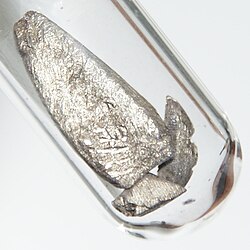Europium
Europium is a chemical element with the symbol Eu and atomic number 63. It is named after the continent of Europe. It is a moderately hard, silvery metal which readily oxidizes in air and water. Being a typical member of the lanthanide series, europium usually assumes the oxidation state +3, but the oxidation state +2 is also common: all europium compounds with oxidation state +2 are slightly reducing. Europium has no significant biological role and is relatively non-toxic compared to other heavy metals. Most applications of europium exploit the phosphorescence of europium compounds.
Occurrence
Depletion or enrichment of europium in minerals relative to other rare earth elements is known as the europium anomaly. Europium is commonly included in trace element studies in geochemistry and petrology to understand the processes that form igneous rocks (rocks that cooled from magma or lava). The nature of the europium anomaly found helps reconstruct the relationships within a suite of igneous rocks.
Divalent europium (Eu2+) in small amounts is the activator of the bright blue fluorescence of some samples of the mineral fluorite (CaF2). The reduction from Eu3+ to Eu2+ is induced by irradiation with energetic particles. The most outstanding examples of this originated around Weardale and adjacent parts of northern England; it was the fluorite found here that fluorescence was named after, although it was not until much later that europium was determined to be the cause.
| Symbol | Eu | |
| Atomic Number | 63 | |
| Atomic Weight | 151.965 | |
| Oxidation States | +2, +3 | |
| Electronegativity, Pauling | 1.2 | |
| State at RT | Solid, Metal | |
| Melting Point, K | 1095 | |
| Boiling Point, K | 1870 |
Appearance and Characteristics
Harmful effects:
Europium is considered to be mildly toxic. The metal dust is considered to be a fire and explosion hazard.
Characteristics:
- Europium is a soft, ductile, silvery-white metal that instantly oxidizes in air.
- It is the most reactive of the rare earth metals and ignites in air at temperatures in excess of 150 oC to 180 oC.
- In water it reacts in a similar way to calcium, producing europium hydroxide and hydrogen gas.
- Unlike most other rare earth metals, europium can form stable compounds in the divalent state, Eu2+ (europous) as well as the usual trivalent state, Eu3+ (europic).
Uses of Europium
- Europium oxide (europia) is widely used as a doping agent in phosphors in television sets and computer monitors: valency three europium produces a red radiance and valency two europium produces a blue radiance. When both valencies are combined a white light is produced which is used in compact fluorescent bulbs.
- Europium is also used in phosphors in anti-forgery marks on Euro bank notes.
- Europium isotopes are good neutron absorbers and are used in nuclear reactor control rods.
